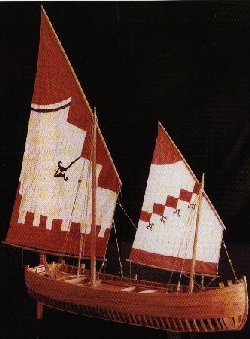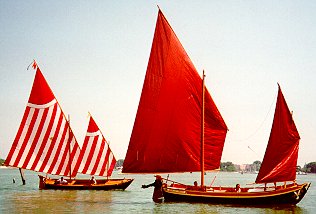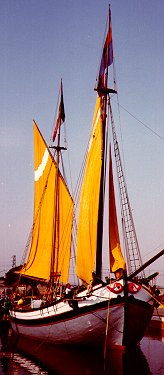SEA-GOING
BOATS

The Bragòsso
was the most commonly-used fishing-boat in the northern
Adriatic for most of the nineteenth century and the first
half of the twentieth century. Until the advent of the
motor, with which the bragòsso tried to
co-exist for a while, it proved to be perfect for fishing
in this area which is characterized by shallow waters,
moderate winds and a calm sea. It measured from 9 to 16 metres, with a width a quarter of its
length, with a flat
bottom with a slight longitudinal sheer which became more
pronounced at the stern and bow.
 The stern was squared,
the bow rounded, with the stems curved in a vertical half-moon. The sides were perpendicular in the higher
part, becoming more curved towards the bottom where they
joined forming an edge. The bragòsso had no
rakes and a large uncluttered deck used to rearrange the
nets and sorting the catch. The width of the bottom,
which was constant for nearly the entire length of the
boat, considerably reduced the draught (about 45 cm for
10 tons), a useful feature in the northern Adriatic with
its shallow and sandy coasts and frequently silted-up ports. To counteract the leeway in the bowline
tack, the
surface area of the rudder was greatly increased which,
being over 4 metres high, reached well below the bottom
of the boat, and could be raised or lowered according to
the available depth. It was raised and lowered on long
metal runners like a normal centreboard.
The stern was squared,
the bow rounded, with the stems curved in a vertical half-moon. The sides were perpendicular in the higher
part, becoming more curved towards the bottom where they
joined forming an edge. The bragòsso had no
rakes and a large uncluttered deck used to rearrange the
nets and sorting the catch. The width of the bottom,
which was constant for nearly the entire length of the
boat, considerably reduced the draught (about 45 cm for
10 tons), a useful feature in the northern Adriatic with
its shallow and sandy coasts and frequently silted-up ports. To counteract the leeway in the bowline
tack, the
surface area of the rudder was greatly increased which,
being over 4 metres high, reached well below the bottom
of the boat, and could be raised or lowered according to
the available depth. It was raised and lowered on long
metal runners like a normal centreboard.
The bragòsso was low, completely decked, with
no structures on deck, with two main hatches and two
smaller hatches at the bow. It had two masts, the main
mast strictly at a third of the length of the boat, and
the foremast at about 3/4 from the stern, inclined
forwards about 10/15 degrees, without fixed rigging apart
from a shroud (sàrcia) on the left. It had two
trapezoidal sails called al terzo for the point
of the spar on which the halliard was rigged. ![]()
The Tòpo
is a lagoon and coastal boat with a flat bottom, and
varies from 6 to 14 m in length. It has rounded sides and
a rounded stern with a vertical stem and the bow extended forwards.
 There are many
variations of this boat which can be decked or left open
depending on how and where it is used. Also known as batello
a pìsso, mùsso or musséto, topéto,
tòpo mistieréto, tòpo venessiàn, batèlo
col filo. It was used for transport and fishing,
both with oars and sail. Nowadays it is motorized (mototopo)
or with a straight-cut stern, and is the most widely-used
transport boat in the lagoon.
There are many
variations of this boat which can be decked or left open
depending on how and where it is used. Also known as batello
a pìsso, mùsso or musséto, topéto,
tòpo mistieréto, tòpo venessiàn, batèlo
col filo. It was used for transport and fishing,
both with oars and sail. Nowadays it is motorized (mototopo)
or with a straight-cut stern, and is the most widely-used
transport boat in the lagoon. ![]()
Trabàcolo: well-known
transport boat about twenty metres long, with two masts
and bowsprit, widely used in all areas of the northern Adriatic. It was built following the classic rules of
naval construction with timbers on a keel, unlike the
other similar-sized boats of the same area which were
built with a flat bottom (bragòsso, tartàna,
etc.).
 The trabàcolo
was rigged with sails (vele al terzo) which,
starting from the aft sail, were gradually replaced with
gaff sails with fixed rigging in steel wire with ratlines
on the shrouds. It was fully-shaped and folded back when
not in use and thin and flared in operation.
The trabàcolo
was rigged with sails (vele al terzo) which,
starting from the aft sail, were gradually replaced with
gaff sails with fixed rigging in steel wire with ratlines
on the shrouds. It was fully-shaped and folded back when
not in use and thin and flared in operation.
It had a straight stern stem with a sliding rudder, a
curved bow stem which curved back in the top part,
surmounted with a carved sheepskin (known as a perùca,
pelizón, or scùfia). Another
characteristic of the trabàcolo are the two
large carved and painted eyes on the sides of the bow
stem (not to be confused with the hawse-holes positioned below).
Without doubt it was a descendent of the small cargo
vessels such as the cocca veneta, and was used
to transport building materials such as wood and stone
between Yugoslavia and Italy. A smaller version, the barchétto,
was used in Romagna for fishing. The few surviving
examples of the trabacolo are used for recreation. ![]()